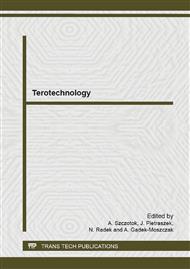[1]
R.J. Wang, Y.Y. Qian, J. Liu, Physical characteristics and photoluminescence properties of phosphorous-implanted ZnO thin films, Appl. Surf. Sci. 228 (2004) 405-409.
Google Scholar
[2]
W. Ruijun, Q. Yiyu, L. Jun, Interface behavior study of WC92–Co8 coating produced by electrospark deposition, Appl. Surf. Sci. 240 (2005) 42-47.
DOI: 10.1016/j.apsusc.2004.05.299
Google Scholar
[3]
E.I. Zamulaeva, E.A. Levashov, A.E. Kudtyashov, P.V. Vakaev, M.I. Petrzhik, Electrospark coatings deposited onto an Armco iron substrate with nano- and microstructured WC–Co electrodes: Deposition process, structure, and properties, Surf. Coat. Tech. 202 (2008).
DOI: 10.1016/j.surfcoat.2008.01.008
Google Scholar
[4]
N. Radek, The influence of laser treatment on the microstructure and properties of the tungsten carbide electrospark coatings, Adv. Manuf. Sci. Tech., 35 (2011) 59-71.
Google Scholar
[5]
I.V. Galinov, R.B. Luban, Mass transfer trends during electrospark alloying, Surf. Coat. Tech. 79 (1996) 9-18.
DOI: 10.1016/0257-8972(95)02434-4
Google Scholar
[6]
M. Scendo, Potassium ethylxanthate as corrosion inhibitor for copper in acidic chloride solutions, Corros. Sci. 47 (2005) 1738-1749.
DOI: 10.1016/j.corsci.2004.08.015
Google Scholar
[7]
M. Scendo, Corrosion inhibition of copper by potassium ethylxanthate in acidic chloride solutions, Corros. Sci. 47 (2005) 2778-2791.
DOI: 10.1016/j.corsci.2004.12.001
Google Scholar
[8]
Y.A. Balaban, S.U. Kandemir, Investigation on some Schiff bases as HCl corrosion inhibitors for carbon steel, Mater. Chem. Phys. 85 (2004) 420-426.
DOI: 10.1016/j.matchemphys.2004.01.033
Google Scholar
[9]
A.K. Singh, M.A. Quraishi, Investigation of adsorption of isoniazid derivatives at mild steel/hydrochloric acid interface: Electrochemical and weight loss methods, Mater. Chem. Phys. 123 (2010) 666-677.
DOI: 10.1016/j.matchemphys.2010.05.035
Google Scholar
[10]
M. Scendo, M. Hepel, Inhibiting properties of benzimidazole films for Cu(II)/Cu(I) reduction in chloride media studied by RDE and EQCN techniques, Corros. Sci. 49 (2007) 3381-3407.
DOI: 10.1016/j.corsci.2007.03.022
Google Scholar
[11]
M. Scendo, The effect of purine on the corrosion of copper in chloride solutions, Corros. Sci. 49 (2007) 373-390.
DOI: 10.1016/j.corsci.2006.06.022
Google Scholar
[12]
M. Itagaki, M. Tagaki, K. Watanabe, Application of a wall jet disk electrode combined with an electrochemical quartz crystal microbalance to the study of the dissolution of copper in acidic chloride media, J. Electroanal. Chem. 440 (1997).
DOI: 10.1016/s0022-0728(97)80049-6
Google Scholar
[13]
G.G. Long, M. Ujvari, G. Horangi, New EQCM, voltammetric and radiotracer evidences proving the role of Cu+ ions in the behavior of the Cu2+–Cu system, J. Elactroanal. Chem. 522 (2002) 179-188.
DOI: 10.1016/s0022-0728(02)00721-0
Google Scholar
[14]
A. Conde, J. Garcia, J.J. de Damborenea, Pitting corrosion of 304 stainless steel after laser surface melting in argon and nitrogen atmospheres, Corros. Sci. 43 (2001) 817-828.
DOI: 10.1016/s0010-938x(00)00114-1
Google Scholar
[15]
C.Y. Cui, J.D. Hu, Y.H. Liu, K. Gao, Z.X. Guo, Formation of nano-crystalline and amorphous phases on the surface of stainless steel by Nd: YAG pulsed laser irradiation, Appl. Surf. Sci. 254 (2008) 6779-6782.
DOI: 10.1016/j.apsusc.2008.04.069
Google Scholar
[16]
S. Yang, Z.J. Wang, H. Kokawa, Y.S. Sato, Reassessment of the effects of laser surface melting on IGC of SUS 304, Mater. Sci. Eng. A 474 (2008) 112-119.
DOI: 10.1016/j.msea.2007.03.103
Google Scholar
[17]
M. Scendo, N. Radek, J. Trela, Influence of laser treatment on the corrosive resistance of WC-Cu coating produced by electrospark deposition, Int. J. Electrochem. Sci. 8 (2013) 9264-9277.
DOI: 10.1016/j.surfcoat.2014.10.062
Google Scholar


